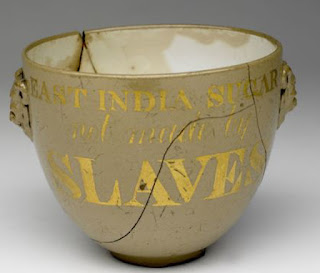Quaker Elizabeth Coleman Heyrick (1769-1831) of Leicester
In 1824 Englishwoman Elizabeth Coleman Heyrick published a pamphlet titled Immediate Not Gradual Abolition, promoting the idea that slavery should be abolished now rather than in the rosy future.
Heyrick started activists thinking against gradual emancipation. The concept was radical, not only in its consequences but in the fact that a woman made the proposal. She also proposed that people stop using sugar grown and processed in the Caribbean, the "West Indies", by slaves.
Sugar cane and slave labor in the Caribbean
A sugar boycott had been discussed for several decades. Britain outlawed slavery at home but allowed it to continue in the colonies.
Activists proposed women substitute East India sugar grown in Pacific islands---what is now Indonesia.
The Barbarities of the West Indies
by James Gillray, 1791
R. Henderson advertised he sold an assortment
of abolitionist "sugar basins."
A virtual collection of abolitionist sugar basins
meant to hold sugar not produced by enslaved workers.
And a tea pot
Antisaccharrites by Gillray
The tea drinkers appear to be King George III, Queen Charlotte
and a few of their many unhappy children.
"Oh ye who at your ease
Sip the blood-sweeten'd beverage"
Robert Southey, Poems on the Slave Trade
One important aspect of the sugar boycott of the 1820s in England and the United States was that women asserted their power as consumers and reformers. In the year following Heyrick's pamphlet, Englsihwomen established the Birmingham Ladies Society for the Relief of Negro Slaves, assumed to be the first female antislavery organization.
English Berlin Work
Royal Museums Greenwich
According to Beth A. Salerno in Sister Societies: Women's Antislavery Organizations in Antebellum America, by the end of 1833 there were seven female antislavery societies in the United States, the beginning of a trend to female activism. In 1837 there were 45 female societies.
"Remember the Slave"
Coin Purse in the Lynn [MA]
Museum & Historical Society.
See more here:https://ordinaryphilosophy.com/2016/04/30/frederick-douglass-lynn-sites-part-2-historical-society-hutchinson-scrapbook/
Read about anti-slavery needlework at these posts:
http://barbarabrackman.blogspot.com/2010/11/abolitionist-embroidery.html
http://barbarabrackman.blogspot.com/2010/11/abolitionist-embroidery-2.html


















1 comment:
Fabulous! The ladies must have been heard. Britain held legislative hearings before deciding what mechanism was best to abolish slavery.The testimony of witnesses on how attempts at gradual abolition had played out in the various states of the US is fascinating, there were many unintended consequences along the way as gradual abolition moved toward the total end of slavery. In 1832, Britain decided on sudden and complete abolition after the slaves and slave owners had had a bit of time to prepare, knowing the date when freedom was coming. Many wealthy slaveowners in the colonies moved to England before the date arrived, where they were offered sanctuary and were safe from feared mob retribution.
Post a Comment